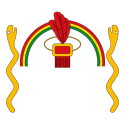Inca Empire
Inca Empire Tawantinsuyu (Quechua) | |
|---|---|
| 1438–1533/1572 | |
|
Inca imperial banner | |
 The Inca Empire at its bigest size c. 1525 | |
| Capital | Cusco |
| Official languages | Quechua |
| Religion | Inca religion |
| Government | Divine, absolute monarchy semi-diarchy |
| Historical era | Pre-Columbian era |
• Pachacuti created the Tawantinsuyu | 1438 |
| 1529–1532 | |
• Spanish conquest of the Inca Empire by Francisco Pizarro | 1533/1572 |
• End of the last Inca resistance | 1572 |


The Inca were a pre-Columbian country and empire in the Andes of South America. The word Inca can also mean the emperor or king of the Inca people. It was the largest empire in the Americas, and was large even by world standards. It existed shortly before Christopher Columbus arrived in the Americas.
The Inca ruled along the western coast of South America for a little over 100 years, until the Spanish invasion in the 16th century. The empire was centered around the city of Cuzco, or Qosqo, in what is now southern Peru. This was the administrative, political and military center of the empire. In later years, it was also centered around Quito. The Inca were ruled by an Emperor known as the Sapa Inca. Throughout their empire, they built many roads and bridges to make travel between their communities easy.
The Inca Empire was called Tawantinsuyo in Quechua, which means "four regions". The empire only lasted for about 100 years as the arrival of the conquering Spaniards in 1532 AD marked the end of their reign. Their main language was Quechua, but as the Empire was made up of many different groups there were probably many different languages as well.
The Inca Empire began around Lake Titicaca in about 1197. From 1438 to 1533, the Incas used conquest and non-violent assimilation to gain a large portion of western South America. Their empire centered on the Andean mountain ranges. It included large parts of what is now Ecuador, Peru, Bolivia, Argentina and Chile.
In 1533, Atahualpa, the last sovereign emperor, was executed by the conquistador Francisco Pizarro. That meant the beginning of Spanish rule in South America. The Inca Empire was supported by an economy based on the collective ownership of the land.
Bibliography
[change | change source]- Popenoe, Hugh et al 1989. Lost crops of the Incas. Washington DC: National Academy Press.
- De la Vega, Garcilaso 1961. The Incas: the royal commentaries of the Inca. New York: The Orion Press.
- McNeill, William H. 2006. How the potato changed the world's history. Social Research 66 1.
Other websites
[change | change source]- Conquest of Peru, Prescott, 1847 Full text, free to read and search, a definitive history of the Incas. One of the most readable and engaging history books of all time. Humankind lost a civilization of impressive societal value.
- Inca Land by Hiram Bingham (published 1912–1922)
- Inca Artifacts, Peru, and Machu Picchu Archived 2007-01-29 at the Wayback Machine 360 degree movies of inca artifacts and Peruvian landscapes.
- Inca civilization and other ancient civilizations by Genry Joil.
- Inca stone cutting techniques: theory on how the Inca walls fit so perfectly.
- Ancient Civilizations - Inca Archived 2007-02-04 at the Wayback Machine Great research site for kids.
- Incan Ice Mummies NOVA site based on their series about the 1996 expedition that discovered Incan ice mummies.
- Incan Religion Archived 2007-03-05 at the Wayback Machine
